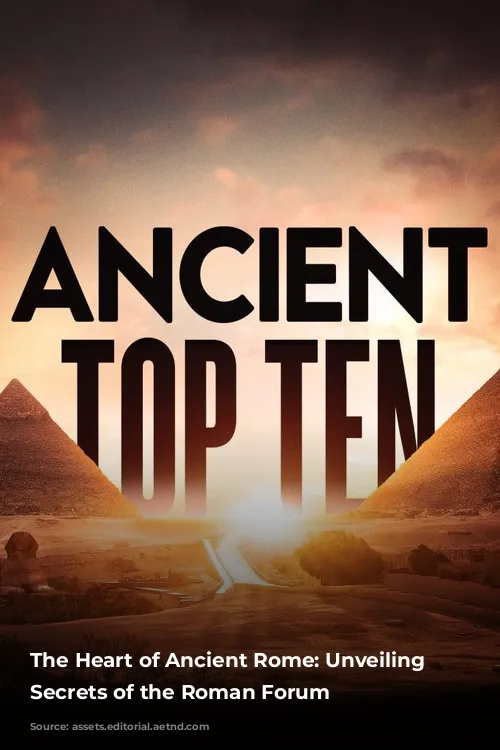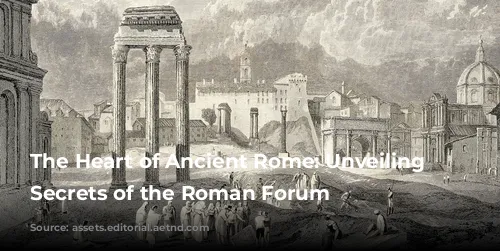The Roman Forum, a bustling hub of ancient Rome, stood at the very heart of the city. More than just a marketplace, it was a dynamic place where religion, politics, and social life intertwined. This rectangular space, nestled between Palatine Hill and Capitoline Hill, housed some of Rome’s most impressive temples and monuments. Today, it remains a magnet for tourists, drawing over 4.5 million visitors each year who come to witness the echoes of a bygone era.

From Humble Beginnings to a City’s Soul
The story of the Roman Forum is deeply intertwined with the founding of Rome itself. Legend has it that the city was established by the brothers Romulus and Remus in 753 B.C. A bitter rivalry led to Romulus killing Remus, and he crowned himself king, naming the city after himself. Interestingly, the tale also suggests that Romulus later formed an alliance with his rival, Titus Tatius, and they designated the Forum as a neutral meeting ground, laying the foundation for its vital role in Roman society.
Initially, the Forum served as a simple marketplace, a place for everyday transactions. But as Rome grew, so did the Forum’s purpose. It gradually evolved into a center for public affairs, the beating heart of the city’s social and political life.
Historians believe that the Forum’s transformation into a focal point for public events began around 500 B.C., coinciding with the establishment of the Roman Republic. The Forum’s influence and significance continued to expand over centuries. As Rome grew in power and influence, so too did the Forum, with new structures being erected to accommodate the increasing number of gatherings.
A Place of Power and Beauty: Exploring the Forum’s Architecture
The Forum was a multi-purpose space, a vibrant tapestry of activity. It played host to everything from gladiator matches (before the Colosseum was built) to political speeches and religious ceremonies. Many of these events took place in impressive buildings, including:
- The Senate House (Curia): This was the meeting place for the Roman Senate, a powerful body that held immense sway in Roman politics. The Senate House was rebuilt several times over the centuries, and in the 7th century, it was converted into a church.
- The Temple of Saturn: Dedicated to Saturn, the god of agriculture, this temple held the Roman treasury, where the city’s wealth was stored and managed. The current ruins date back to 42 B.C. after earlier structures were rebuilt.
- The Arch of Titus: This iconic arch was built by Emperor Domitian in 81 A.D. to commemorate the victory of his brother, Emperor Titus, in the Siege of Jerusalem.
- The Temple of Vesta: Dedicated to Vesta, the goddess of hearth, home, and family, this circular temple was a prominent fixture in the Forum.
- The Rostra: This platform was used for public speeches, a crucial tool for political discourse and public communication.
- The Temple of Castor and Pollux: Dedicated to the twin demi-gods Castor and Pollux, this temple underwent several construction phases and is believed to have been completed around 484 B.C.
The Sacra Via, the main road running through the Forum, connected these important sites and extended to the Colosseum, within walking distance of the Forum. It served as the route for processions and ceremonies, a visual testament to the Forum’s importance in Roman life.
A Legacy of Architecture and Art
The Roman Forum’s evolution over centuries left a unique mark on its architecture. Buildings from various eras were constructed and reconstructed, blending different styles and materials. The Romans were deeply influenced by classical Greek architecture, but they also developed their own signature structures, including basilicas, triumphal arches, domes, baths, and amphitheaters. From sturdy concrete to elegant marble, they employed a range of materials, reflecting the city’s growing wealth and architectural ingenuity.
The Roman Forum’s enduring legacy is not only its architectural splendor but also its influence on art and literature. The Forum’s ruins inspired generations of artists, most notably the Italian artist Giambattista Piranesi, who created a series of etchings depicting the city’s grand grandeur. The Forum’s significance is further evident in its presence in historic literature, with ancient Rome serving as the backdrop for several of William Shakespeare’s plays.
Decline and Rediscovery: The Forum’s Resurgence
Over time, economic and political events led to the development of new structures north of the Forum, signaling a shift in the city’s center of activity. The last major expansion of the Forum was the Basilica of Maxentius, constructed during the reign of Constantine in 312 A.D.
However, the Forum’s grandeur was short-lived. By 410 A.D., around the time the Roman Empire began to crumble, the Forum’s structures were largely destroyed. During the Middle Ages, the once-grand Forum was reduced to a cattle pasture, a far cry from its former glory.
The Forum was eventually “rediscovered” in 1803 by archaeologist Carlo Fea. The excavation process, which took over a century, revealed the Forum’s buried secrets and brought the ancient city back to life. The Forum’s ruins, layered with the remnants of centuries of history, offered a unique glimpse into Roman civilization.
The Forum Today: Unraveling the Mysteries of the Past
Today, the Roman Forum remains a captivating destination for visitors who wish to step back in time. The ongoing excavation and restoration efforts are crucial for preserving these invaluable remnants of Roman history. New discoveries continue to shed light on the Forum’s past, rewriting our understanding of Rome’s origins.
For instance, in 2009, archaeologists unearthed pottery remains and food scraps dating back to the 8th or 9th century B.C., predating the traditional date of Rome’s founding. These findings offer compelling evidence of a richer and more complex history than previously thought.
The Roman Forum, despite the passage of centuries, continues to speak to us, offering unparalleled insight into the rise and fall of one of history’s most influential empires. The mysteries hidden beneath its ruins serve as a constant reminder of the power of history to shape the present and inspire the future.
